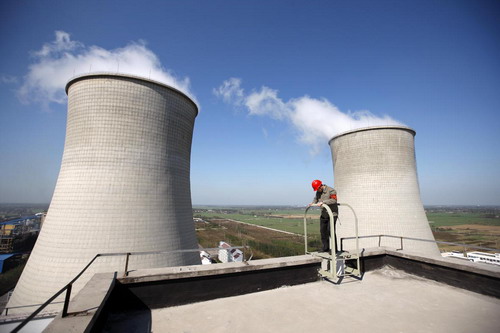Carbon emissions cuts set for testing by 2013, sources say
Updated: 2011-11-11 15:46
By Zhou Yan (China Daily)
|
|||||||||||
|
A worker examines equipment at a power station in Huaibei city, Anhui province. [Photo/China Daily] |
BEIJING - Five cities and two provinces have been chosen to test controls on carbon dioxide emissions, probably starting in 2013, sources with knowledge of the matter said.
The regions are the four municipalities directly under the central government - Beijing, Tianjin, Shanghai and Chongqing - as well as the city of Shenzhen and the provinces of Guangdong and Hubei, said a source speaking on condition of anonymity.
These regions have submitted detailed plans that cover emissions caps, quota allocations, third-party verifiers of emissions cuts, enforcement of trading emissions consumption quotas and excess emissions penalties. The plans were submitted to the National Development and Reform Commission (NDRC) for approval, the source said.
The pilot program is expected to start by 2013 and go nationwide in 2015. "Plans from different regions vary according to local conditions," the source said.
Xu Xiaodong, a researcher in the Counselors' Office of the State Council, said during the Second China International Gas Energy Summit that the carbon-emissions trading market "will come out in the near future".
The moves are in line with the objectives of the 12th Five-Year Plan (2011-2015) to cut carbon emissions by 17 percent.
The State Council, or cabinet, on Wednesday approved a work program to control greenhouse gas emissions from 2011 to 2015.
The council said that there would be a pilot emissions control program and possibly a carbon emissions trading market.
China will start with voluntary emissions cuts and explore market-oriented measures to realize reduction targets, said Su Wei, director-general of the NDRC's climate change department.
The Ministry of Industry and Information Technology urged local authorities as early as March to set targets, and the ministry said it would step up oversight of major energy users.
Proposals for absolute carbon caps on power generation and other energy-intensive industries are being discussed, the source said.
"China can adopt both an absolute carbon cap and voluntary carbon trading in the beginning to test the waters, then gradually consolidate the two measures," Mei Dewen, president of the China Beijing Environment Exchange, suggested.
Based on experience in Europe, "it will take a long time for the market to mature", Mei said.
Europe has the world's biggest carbon market. The emissions trading program began in 2005, but only after seven to eight years of research, Mei said.
According to Wang Shancheng, deputy chief of the Department of Resource Utilization and Environmental Protection of the NDRC, China's primary energy consumption will reach 4.1 billion tonnes of standard coal by 2015, meaning the country has far to go to restructure its energy use.
China must balance strong economic growth and energy consumption, Mei said, adding that emissions trading would spur energy industry reform and market-oriented operations.









